 Image search results - "koku" Image search results - "koku" |

Ryogoku Kokugikan sumo arena as seen from Ryogoku Station
|
|

The Kokugikan as seen from JR Ryogoku Station platform.
|
|
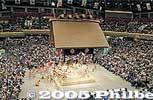
More people than the real tournamentAbout 8,000 people took time out from their Golden Week holidays to see this official sumo practice of all sumo stables.
|
|

Crowd outside the Kokugikan await their favorite wrestlers.
|
|
|
|

Crowd enters the Kokugikan for Musashimaru's retirement ceremony on Oct. 2, 2004.
|
|

Yokozuna Deliberation Council membersIn the middle is Kitanoumi.
|
|

Passing out programs
|
|
|
|

Musashimaru at the entrance
|
|

Sumo elders in the front row
|
|

Musashimaru greets the crowd
|
|

Former yokozuna Taiho, Takanosato, Kotozakura, and Wakanohana watch intently.
|
|

Way to Kokugikan. The guarded side gate on the right is for sumo wrestlers.
|
|

Hawaii's last sumo wrestler shakes hands.If he were married, his wife would be beside him.
|
|

Asashoryu greets the council upon entry
|
|

Taiko drum tower
|
|

Musashimaru right after I shook his hand.
|
|

Asashoryu sips water offered by Ozeki ChiyotaikaiAs soon as Asashoryu entered the arena, many wrestlers went up to him to offer water as a show of respect.
|
|

Taiko drum tower
|
|

Signboard for retirement ceremony at entrance.It reads "Musashimaru, Intai Danpatsu Hiroo Ozumo" which means "Musashimaru Topknot-Cutting and Retirement Sumo Exhibition."
|
|
|

Asashoryu and TochiazumaAfter offering water, Tochiazuma shares a laugh with the yokozuna.
|
|

Sumo wrestler banners
|
|

Musashigawa stablemaster (former Yokozuna Mienoumi) in the entrance hallInside the entrance hallway, there was a long table on the left side with ribbons which served as name tags for distinguished guests. Musashigawa is the name of Musashimaru's sumo stable.
|
|
|

Sumo wrestler and sumo stable banners
|
|

Entrance hall is clogged up by a side show of hula.
|
|

Friends after allKyokushuzan chats with fellow Mongolian Asashoryu.
|
|

Kokugikan
|
|

Musashigawa Stable wrestlers greet visitorsIncludes Miyabiyama and Musoyama.
|
|

Practice
|
|

Kokugikan ticket office (right). Ticket prices range from 2,100 yen to 14,300 yen.
|
|

In the entrance hall, hula and Hawaiian music direct from Hawaii
|
|
|

Kokugikan ticket office. Cheap tickets costing 2,100 yen are sold every day of the tournament, but sell out fast by noon or so.
|
|

The retirement ceremony had a lot of Hawaiian touches. This was only the beginning.Hula dancers and live Hawaiian band from Hawaii.
|
|

Me next please!!!The winner gets to decide who to wrestle next. The rikishi all beg to be picked.
|
|

Gate to enter Kokugikan.
|
|

Konishiki also sings. (His company arranged the entertainment.)
|
|

The Bulgarian (Kotooshu) on the left
|
|

At the gate, you might see a famous former wrestler (like former Takamiyama from Hawaii, now Stablemaster Azumazeki) taking your ticket.
|
|

Musashigawa Stable wrestler wearing Aloha-print yukataFlowery pattern (plumeria) with "Musashimaru" imprinted.
|
|

Front of Kokugikan. The wide stairs make it quick for many people to exit the building. It is a sleek, modern building with a spacious interior. The roof collects rainwater for use in the toilets.
|
|

Musashimaru souvenirs at the Kokugikan's souvenir shop
|
|

Ready to pounce on the winner
|
|
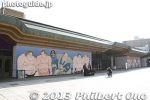
After you go through the ticket gate, the front of Kokugikan has two large murals.
|
|

Musashimaru merchandise
|
|
|
|
|
|
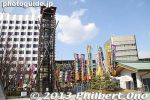
Taiko drum tower
|
|
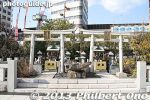
Two small shrines outside.
|
|
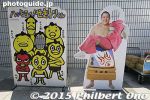
Pose with a cutout of popular rikishi Endo.
|
|
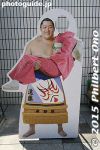
Pose with a cutout of popular rikishi Endo.
|
|
|

Musashimaru doll
|
|

Asashoryu joins in
|
|
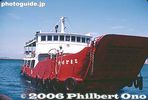
Ferry boat from Takamatsu to Megishima. 20 min. ride.
|
|

JR Kokubunji Station, South Entrance.
|
|

Entrance to Tonogayato Teien Garden, 2-min. walk from Kokubunji Station.
|
|

Koku-Koen Station on the Seibu Shinjuku Line 航空公園駅
|
|

Sumo wrestlers enter through a side entrance. Fans wait for their favorite wrestlers.
|
|
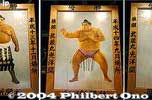
Giant painted pictures of Musashimaru decorating the arena inside. Each one commemorates a tournament victory.These giant pictures are actually black-and-white photographs taken in a photo studio and printed on large paper. Then it is hand-painted in color by a woman who has been doing it for years.
|
|
|
|

Map of Tonogayato Teien Garden.
|
|

Inside Kokubunji Station
|
|

In front of Koku-Koen Station. Notice the paper plane sculpture and YS-11 prop plane.
|
|

Entrance lobby. At the end of the lobby is a trophy showcase. On the last day of the tournament, the tournament winner will walk through here to his car for a victory parade amid a large crowd.
|
|

The ceremony opens with taiko drum beating on the sumo ring.
|
|

Both ozeki watch
|
|
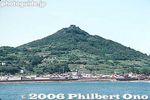
Megishima is associated with Momotaro, a famous folk tale.
|
|

Greenery greets you first.
|
|

Inside Kokubunji Station
|
|

Paper plane sculpture
|
|

Side of lobby. (Passing out free calendar posters during Jan. tourney.)
|
|

Sumo exhibition matches with lower division Makushita wrestlers.A retirement ceremony for an important sumo wrestler includes a variety of activities besides the actual ceremony of cutting away the topknot. It involves almost the entire Japan Sumo Association, and most wrestlers in the top three divisions (Makushita, Juryo, and Makunouchi) also appear in exhibition matches.
|
|
|

ハナモモ はなかいど
|
|

Kokubunji Station, North Exit
|
|

Another sculpture in the Aviation Memorial Park.
|
|

Sumo mural in lobby.
|
|

Makushita sumo matchLower-division wrestlers wear black belts, while the upper division wrestlers wear white belts (during practice) or colored belts during official matches.
|
|
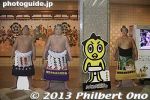
In the entrance hall are life-size cutouts of the top wrestlers.
|
|
|
|

Megishima beach 女木島
|
|
|

Kokubunji Station, North Entrance
|
|

Air Nippon YS-11 propeller plane. Donated by All Nippon Airways in 1997.
|
|

Trophy case in lobby. This is the Emperor's Cup awarded to the tournament winner.
|
|

Juryo Division dohyo-iri ring-entering ceremony
|
|

BreakAsashoryu took a water break between each practice bout.
|
|
|
|

Kokubunji Station, North side
|
|

YS-11 propeller plane. Open to the public on certain days of the year.
|
|

Emperor's Cup. This is what all sumo wrestlers dream about.
|
|

Juryo sumo match
|
|
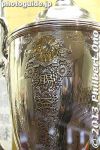
Closeup of Emperor's Cup.
|
|

I'm waiting...
|
|
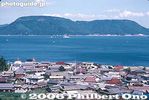
View from lookout deck
|
|
|
|

Shopping street near North side of Kokubunji Station
|
|

Front of YS-11 propeller plane.
|
|

Nameplates of tournament winners on Emperor's Cup
|
|

Hairdressing demonstration
|
|
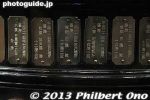
Closeup of nameplates of tournament winners on Emperor's Cup.
|
|
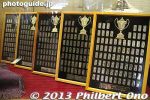
Old Nameplates of tournament winners that were on the Emperor's Cup.
|
|
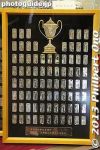
Old Nameplates of tournament winners that were on the Emperor's Cup.
|
|
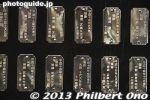
Closeup of old Nameplates of tournament winners that were on the Emperor's Cup.
|
|

Asashoryu gets thrown
|
|
|

Propeller
|
|
|
|

Sumo match with kidsA retirement ceremony for an important sumo wrestler includes a variety of activities besides the actual ceremony of cutting away the topknot. It involves almost the entire Japan Sumo Association, and most wrestlers in the top three divisions (Makushita, Juryo, and Makunouchi) also appear in exhibition matches.
|
|
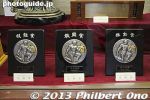
Plaques for the Three Outstanding Prizes (Technique, Outstanding Performance, and Fighting Spirit) awarded by two newspapers.Technique Prize (Gino-sho), Outstanding Performance (for most Yokozuna/Ozeki upsets, Shukun-sho), and Fighting Spirit (Kanto-sho).
|
|
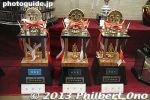
Trophies for the Three Outstanding Prizes (Technique, Outstanding Performance, and Fighting Spirit) from the Japan Sumo Association.Technique Prize (Gino-sho), Outstanding Performance (for most Yokozuna/Ozeki upsets, Shukun-sho), and Fighting Spirit (Kanto-sho).
|
|

A "darn it" look on his face
|
|

Seto Inland Sea as seen from Megishima, Kagawa Pref.
|
|
|

Part of the original runway at the Tokorozawa Aviation Memorial Park. 所沢航空記念公園
|
|

The tournament winner receives numerous prizes from various organizations and companies.
|
|

A retirement ceremony for an important sumo wrestler includes a variety of activities besides the actual ceremony of cutting away the topknot. It involves almost the entire Japan Sumo Association, and most wrestlers in the top three divisions (Makushita, Juryo, and Makunouchi) also appear in exhibition matches.
|
|
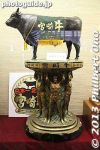
Prize from Miyazaki Prefecture.
|
|
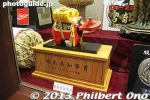
Prize from Fukushima Prefecture.
|
|
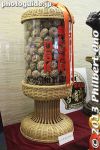
Mushrooms from Oita Prefecture.
|
|
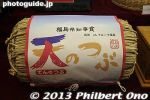
Another prize from Fukushima Prefecture.
|
|
|
|

Hanamomo
|
|

Tokorozawa Aviation Memorial Park. 所沢航空記念公園
|
|

Prime Minister's Cup on left, the middle is the President Chirac Award from France, and the glass on the right is a prize from the Czech Republic.President Chirac is a sumo fan. There is also a Czech wrestler in the lower division.
|
|
|

Butsuri keiko
|
|
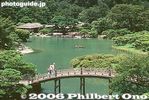
Engetsukyo Bridge, symbol of Ritsurin Park. 栗林公園 偃月橋
|
|
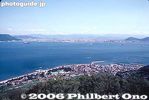
Looking toward Takamatsu
|
|

Hanamomo
|
|

Tokorozawa Aviation Museum. The building on the left is an IMAX theater, and the larger structure on the right is modeled after a blimp on the inside to show retired planes and helicopters. Looks like jet turbine too. 所沢航空発祥記念館
|
|

Prize from the United Arab Emirates.
|
|

The kids gradually get bigger.
|
|

Takamisakari for butsuri keikoEverybody cheered whenever he entered the ring.
|
|
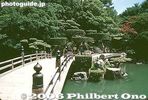
Crossing the bridge
|
|

しゃが
|
|

In front of Tokorozawa Aviation Museum is a Curtiss-Wright C-46 transport plane.
|
|

In the back on the left is a prize from Mexico and one from Hungary on the right. In the front on the left is a prize from Mongolia, middle is from NHK, and right is from China.
|
|

Ozeki Musoyama is defeated.
|
|
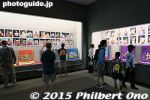
Sumo museum
|
|

Asashoryu exchanges a few wordsAfter the practice was over at 11 am, the sole yokozuna went over to the council.
|
|

North Pond
|
|
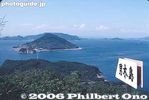
Looking toward Ogishima in Seto Inland Sea. 男木島
|
|

Bamboo grove
|
|

The C-46 was used by the Japan Air Self-Defense Forces for cargo transport from the 1950s.
|
|

Sumo Museum. Open only during tournament days. Free admission.The wall on the left show portraits of all the yokozuna in the modern era.
|
|

Yobidashi wearing Aloha-print garb
|
|
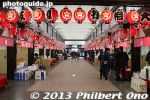
Sumo service entrance for groups.
|
|

Finish, everybody out please...
|
|
|
|
|

Monument for Japan's Birth of Aviation 日本の航空発祥の地・所沢
|
|

Corridor and souvenir shops.A corridor encircles the arena.
|
|
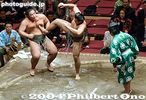
Comic sumo (shokkiri sumo)This is comedy time with two young wrestlers performing various comical antics (spitting at each other, kicking, and other illegal sumo acts) on the ring.
|
|

Leaving Megishima
|
|
|

Takenoko bamboo shoot
|
|

Monument for Japan's Birth of Aviation 日本の航空発祥の地・所沢
|
|

Sumo figurines.
|
|

Comic sumo (shokkiri sumo)This is comedy time with two young wrestlers performing various comical antics (spitting at each other, kicking, and other illegal sumo acts) on the ring.
|
|
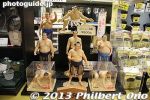
Sumo figurines.
|
|
|
|
|
|
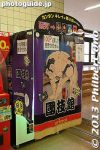
Print Club photo sticker booth.
|
|
|

Back of Monument for Japan's Birth of Aviation日本の航空発祥の地・所沢
|
|

Kokugikan Cafe snack bar
|
|

Tidying up the ring
|
|
|
|
|

Bios and pictures of all sumo wrestlers in top Makunouchi division.
|
|

Musashimaru finally appears for a yokozuna belt demo
|
|

Bato Kannon on top of a hill. 馬頭観音
|
|

Inside the Tokorozawa Aviation Museum. You are greeted by a replica of Kai-1, Japan's first military plane developed, produced, and flown at Tokorozawa on April 5, 1911. It flew 10 meters high and 800 meters long for 80 sec. 会式一号機
|
|

The bios and pictures are categorized according to prefecture. All wrestlers who were/are active in the modern era are introduced. Two wrestlers from Shiga Prefecture: Kurama and Misugisato.
|
|

Musashimaru acknowledges a spectator as he proceeds to the ring.This was a demonstration on how they tie on the thick, white rope (tsuna) around his waist. The tsuna is the symbol of the yokozuna. It takes several assistants to put it on. They are all wearing white gloves.
|
|

Natural spring 湧水
|
|

Other more modern planes and helicopters are on display in the main exhibition hall. This is a North American T6G.
|
|

Non-Japanese sumo wrestlers who made it to Makunouchi Division. Four from USA (Hawaii), four from Mongolia, and one from Bulgaria (Kotooshu) as of 2006.
|
|

Yokozuna "tsuna" belt demo
|
|

Natural spring
|
|

Sikorsky H-19
|
|

Bulgaria (Kotooshu)
|
|

They wrap the rope around his waist from the front, or the thickest part of the rope.This was a demonstration on how they tie on the thick, white rope (tsuna) around his waist. The tsuna is the symbol of the yokozuna. It takes several assistants to put it on. They are all wearing white gloves.
|
|
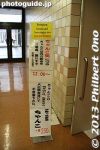
Entrance to the dining room for chanko-nabe. It's downstairs in the basement.
|
|

Natural spring 湧水
|
|

Japan Air Self-Defense Force helicopter.
|
|

Pulling it tight
|
|

The chanko-nabe menu changes a few times during the tournament. The recipes are from various sumo stables.
|
|

次郎弁天の池
|
|

Inside helicopter
|
|
|
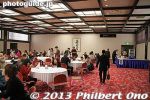
The banquet hall in the basement is used as a dining room during lunch time during tournaments. 大広間
|
|

Benten Pond
|
|

Helicopter cockpit with glass bottom.
|
|

Tying the rope at the back.
|
|
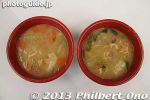
I usually eat two bowls. Only 250 yen per bowl.
|
|

The garden is also noted for fall leaves.
|
|
|

Rear view of the shiranui style of tying the rope.He turned in all four directions to show everyone what it looked like. This is what is called the shiranui style of tying the rope. It is characterized by a single loop in the back. The other style, called unryu, has twin loops.
|
|

It is really good! Different flavors are offered during different days of the tournament. Top is shoyu (soy sauce) flavor, and bottom is salt flavor. Miso flavor is also offered.
|
|

Koyo-tei tea ceremony pavilion 紅葉亭
|
|

Above is a Piper L-21, below is Fuji T-1B.
|
|

Musashimaru goes back and then comes back...
|
|

Lecture classroom (previously used as a dining room for chanko-nabe during tournaments). 相撲教習所
|
|

Koyo-tei tea ceremony pavilion, available for rent.
|
|
|

Next to the chanko dining room is a sumo ring for practice and deliberation exhibition matches.
|
|
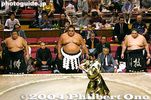
He performs his last yokozuna dohyo-iri ring-entering ceremony. He is flanked by Musoyama on the left as the sword bearer, and Miyabiyama on the right as the dew sweeper.
|
|

The sign reads "Physical body, Technique, Heart." What you need to succeed in sumo.
|
|

View from Koyo-tei
|
|
|

Musashimaru's final dohyo-iriHe could have had Yokozuna Asashoryu be either the sword bearer or dew sweeper, but he chose to have his stablemates to join his final dohyo-iri.
|
|
|
|

Fountain
|
|

Remains of a Nieuport 81E2.
|
|

Musashimaru's final dohyo-iri
|
|

Administrative building which seems to have been part of the Iwasaki villa.
|
|

Replica of Nieuport 81E2. This was first imported to Japan in 1918 and used to train Japanese pilots by a French mission.
|
|

Door to arena.
|
|

Musashimaru's final dohyo-iri
|
|

Inside Administrative building
|
|

Model of Japan's first motorized flight.
|
|
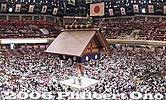
Panorama shot of sumo arena during a sumo tournament. There are two levels.
|
|

Musashimaru's final dohyo-iri
|
|

Chojuji temple Hondo temple hall, National Treasure in Konan, Shiga.The hondo once burned down, but was rebuilt during the Kamakura Period.
|
|

はなにら
|
|

Turbine engines
|
|

Sign for Chichibu-Tama-Kai National Park
|
|

This is the lower level with zabuton box seats costing over 10,000 yen.
|
|

Musashimaru's final dohyo-iri ends
|
|

Grass 大芝生
|
|

Flight simulator (Not as good as Microsoft Flight Simulator.)
|
|

View from Ochiai Bridge
|
|

Box seats. Cramped space for four people.
|
|

He goes back to the dressing room
|
|

Control tower equipment.
|
|

Lookout deck over the gorge
|
|

Box seat for two.
|
|
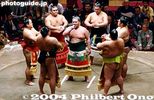
Sumo jinkuThey are singing sumo jinku, a chant-like song about sumo and sumo wrestlers. They are singing about Musashimaru and his career.
|
|

Very impressive and educational aviation museum. Great for kids too.
|
|
|
|

Sumo ring and suspended roof (no pillars).
|
|

Laying the red carpet for the main event.
|
|

Boeing 747 flight simulator (Not as good as Microsoft Flight Simulator.)
|
|
| 823 files on 4 page(s) |
1 |
 |
|